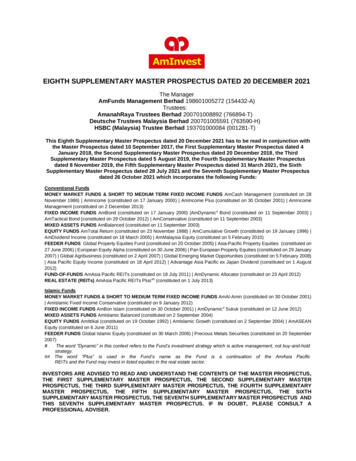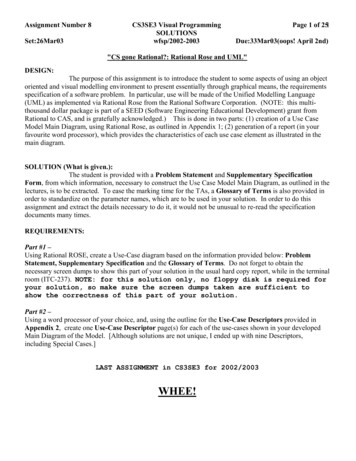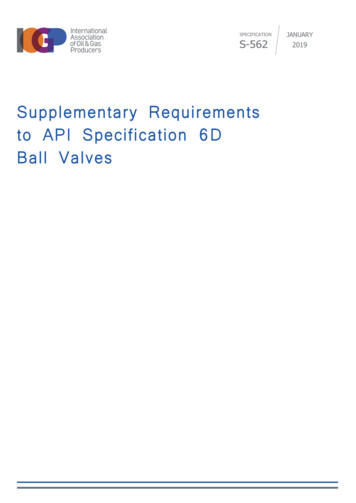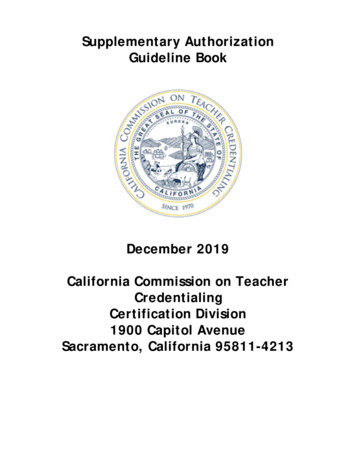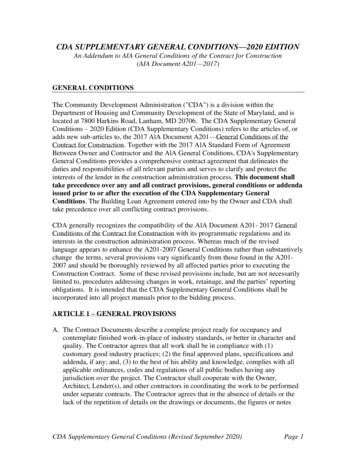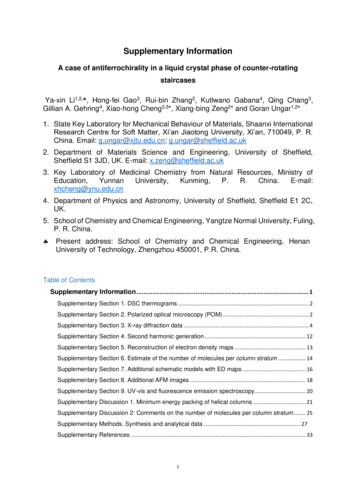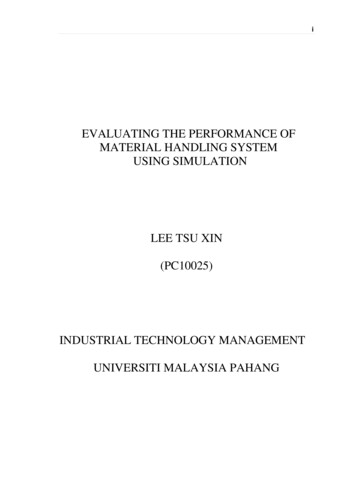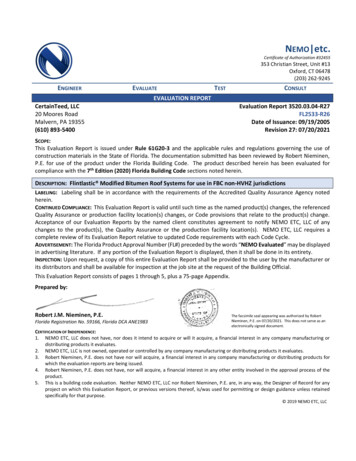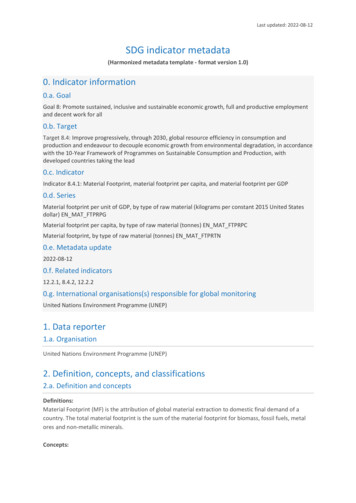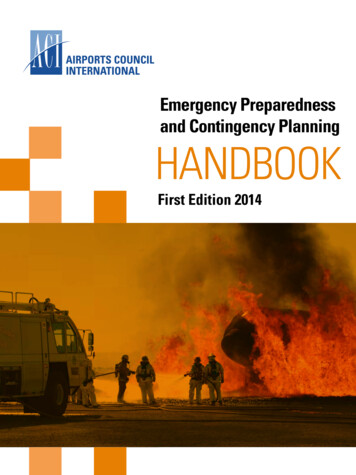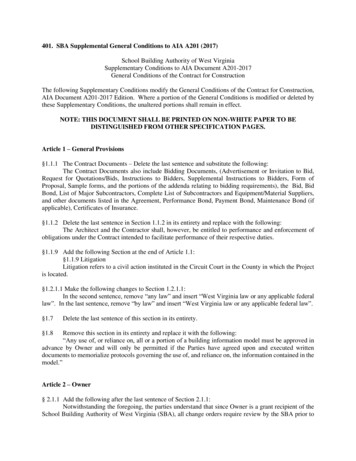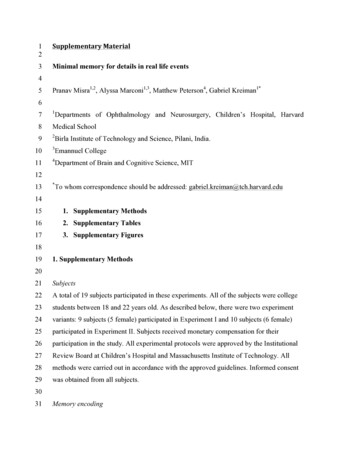
Transcription
12Supplementary Material3Minimal memory for details in real life events45Pranav Misra1,2, Alyssa Marconi1,3, Matthew Peterson4, Gabriel Kreiman1*6718Medical School92Birla Institute of Technology and Science, Pilani, India.103Emannuel College114Department of Brain and Cognitive Science, MIT*To whom correspondence should be addressed: gabriel.kreiman@tch.harvard.eduDepartments of Ophthalmology and Neurosurgery, Children’s Hospital, Harvard121314151. Supplementary Methods162. Supplementary Tables173. Supplementary Figures18191. Supplementary Methods2021Subjects22A total of 19 subjects participated in these experiments. All of the subjects were college23students between 18 and 22 years old. As described below, there were two experiment24variants: 9 subjects (5 female) participated in Experiment I and 10 subjects (6 female)25participated in Experiment II. Subjects received monetary compensation for their26participation in the study. All experimental protocols were approved by the Institutional27Review Board at Children’s Hospital and Massachusetts Institute of Technology. All28methods were carried out in accordance with the approved guidelines. Informed consent29was obtained from all subjects.3031Memory encoding
32Subjects were recruited to participate in a protocol “assessing everyday, natural visual33experience”. The recruitment and task instructions did not include any mention of34“memory” studies. The overall structure of the task was similar to that in previous studies35(St Jacques and Schacter, 2013; Dede et al., 2016; Tang et al., 2016). In the first phase of36the protocol (memory encoding), each subject had to walk along a pre-specified route37(Figure 1B-C). In the second phase of the protocol (memory evaluation), subjects came38back to the lab to perform a memory task (Figure 1E, described below). During the39memory-encoding phase, subjects were not given any task; the instructions were to walk40along the assigned route with the video and eye tracking apparatus (Figure 1A).4142There were two experiment variants.43Experiment I. Subjects were instructed to follow a specified and fixed 2.1-mile route in44Cambridge, MA (Figure 1B). During the preliminary evaluation, we estimated that that it45would take about 55 minutes to complete this route. Subjects spent 59 3.4 minutes46(mean SD) on this route. The experimenter (A.M.) walked behind the subject to47ensure that the equipment was working properly and that the subject was following48the specified route. The route was designed to minimize the number of turns. There49were 3 right turns (Figure 1B), the first one was very clear because the street ended50at that intersection. Thus, there was a maximum of 2 interruptions to provide51directions. Each subject participated in the memory-encoding phase on different52weekdays. Several measures were implemented in an attempt to maximize the53degree of between-subject consistency in the physical properties and subjects’54knowledge / familiarity with the environment: (i) all experiments were run during55the course of two summer months (July/August); (ii) experiments were only56conducted if the weather conditions were approximately similar (i.e. we avoided57rainy conditions or cloudy days since these could provide additional global external58cues, see discussion in the main text); (iii) all subjects started at approximately the59same time of day (between 12pm and 2pm); (iv) all subjects were students60attending Emmanuel College (about three miles away from the specified route) and61were not particularly familiar with the specified route before the beginning of the62experiment.
6364Experiment II. The format of the experiment was similar to Experiment I. In65Experiment II, the route was indoors in order to increase the accuracy of the eye66tracking measurements (see below). Subjects were instructed to follow a specified67and fixed path within the Museum of Fine Arts (MFA) in Boston (Figure 1C). In the68preliminary tests, we estimated that it would take about 50 minutes to complete this route.69Subjects spent 55.4 1.5 minutes (mean SD) on this route. The experimenter (A.M.)70accompanied the subjects to ensure that the equipment was working properly and71that the subject was following the specified route. In addition, the Museum required72that an additional Museum intern accompany the subject during the entire test. The73routes were designed to minimize the number of turns. Subjects had to continue74walking straight, and they were never to go back to the same museum rooms that75had already been visited. There was a total of 12 turns that were not obviously76specified by these two instructions. Subjects performed the test on different77weekdays. Several measures were implemented in an attempt to maximize the78degree of between-subject consistency in the physical properties and subjects’79knowledge / familiarity with the environment: (i) all experiments were run during80the course of two winter months (January/February); (ii) all subjects started at81approximately the same time of day (between 12pm and 2pm); (iii) all subjects82were college students attending Emmanuel College and were not familiar with the83Museum. There was no overlap between the subjects that participated in84Experiments I and II.8586Video recordings and eye tracking87Apparatus. A Mobil Eye XG unit (ASL Eye Tracking, Bedford, MA) was fitted on the88subject along with a GoPro Hero 4 Silver camera (GoPro, San Mateo, CA). The setup is89shown in Figure 1A. The Applied Science Laboratory (ASL) Mobile Eye-XG Tracking90Glasses measure real-world gaze direction at 60 samples per second. The ASL glasses91utilize two cameras: a scene camera and an eye camera. The scene camera sits on top of92the rim of the glasses (Figure 1A). The camera was adjusted for each subject to align93the center of the camera’s field of view (FOV) with the center of the subject. The
94scene camera FOV spanned 64 horizontally and 48 vertically with a resolution of95640 by 480 pixels. To estimate gaze direction, the eye camera records an infrared96(IR) image of the subject’s right eye. The IR image contains two sources of97information for inferring gaze: the center of the pupil and the position of a pattern of98three IR dots from an IR emitter that reflects off the cornea. The eye camera was99adjusted so the three reflected dots were centered onto the subject’s pupil. To100improve the ASL scene camera’s field of view, video quality, and resolution, a GoPro101Hero 4 Silver camera was used, recording at 30 fps with a resolution of 2704 by1022028 pixels and a FOV spanning 110 horizontally and 90 vertically (Peterson et al.,1032016). The GoPro camera was mounted on the center of a Giro bike helmet using a104GoPro front helmet mount. The GoPro camera was mounted on the center of the105helmet, which was positioned 3.5 inches (y-direction) above the scene camera and1060.5 inches (xdirection) to the right (Figure 1A). The GoPro camera has a fish-eye107distortion; therefore, the fixations analyzed when the two cameras were108synchronized focused within the subject’s central region (Peterson et al., 2016).109110Initial Calibration. Once the GoPro camera and eye tracker were properly fitted, the111subject completed a standardized calibration task implemented in the Psychophysics112Toolbox 3.0.10 (Brainard, 1997) written in MATLAB (Mathworks, Natick, MA) on a 13''113MacBook Pro laptop (Apple, Cupertino, CA). Subjects were first asked to fixate on a114centrally presented black dot that contained a white circular center for 2 seconds. After115initial fixation, the same dot moved every 2 seconds through a sequence of 12 other116positions arranged in a 4 x 3 grid space on the screen in pseudo-random order. Once all11713 dots (12 positions center fixation) were fixated upon, the entire array of dots118appeared and subjects were asked to look again at each dot starting at the upper left119corner and moving across each row. The random dot sequence data were used to calibrate120the ASL eye tracker using ASL's Eye XG software. In this process, a rater viewed the121scene camera footage at 8 fps with the pupil and corneal reflection data from the eye122camera overlaid. For each dot transition, the rater waited until the subject moved and123stabilized their gaze on the new dot location, ascertained by an abrupt shift in the overlaid124pupil and corneal reflection data, and used a mouse to click on the center of dot in the
125scene camera image. Once the subject fixated on a new dot, the cursor was moved, and126this was continued for the duration of the calibration. The ASL Eye XG software127computes a function which maps the displacement vector (pupil center to IR dot pattern)128from the eye camera to the pixel coordinates of the dot locations of the scene camera for129each of the 13 calibration dots (Peterson et al., 2016). The subsequent dot array data were130used to validate the initial calibration and estimate error.131132Fixation detection. During the actual experiment, the ASL Eye XG software used the133mapping function computed from calibration to calculate and record the subject's gaze134location relative to the scene camera image. Frames that included blinks or extreme135external IR illuminations (which precluded measurement of the corneal reflection) were136excluded from analyses. A “fixation” was defined by the ASL software’s algorithm as an137event where there were six or more consecutive samples that were within one degree.138139Synchronization of the ASL Eye Tracker and GoPro. To sync the video footage from the140ASL eye tracker to the HD GoPro footage a 12x7 checkerboard pattern was presented on141the monitor during initial calibration. An automated synchronization script searched for142the first frame in the eye tracker scene camera and the GoPro footage when the143checkerboard was first detected and synchronized the videos by aligning the144checkerboard onset times. From this alignment, a projective linear transform matrix was145used to map the 192 vertex points from the ASL to the GoPro’s coordinates. This matrix146was used to map gaze coordinates for each frame and each fixation event from the ASL147to the GoPro videos (Peterson et al., 2016).148149Recalibration of Eye-tracker and GoPro Camera. To validate the subjects’ gaze150coordinates throughout the encoding portion of their study, recalibration was regularly151performed every 5 minutes (Experiment I) or every 10 minutes (Experiment II). During152each recalibration event, the subject held a 12x7 checkerboard at arm’s length and153centered at eye level. Subjects were instructed to fixate for two seconds each at the upper154left (labeled “1”), upper right (labeled “2”), lower left (labeled “3”), lower right (labeled155“4”), and the center (labeled “5”) squares of the checkerboard. Post hoc, the same
156calibration procedure described above was used on each recalibration to correct for any157drifts or other displacements from the previous calibration.158159Analysis of eye tracking data. Despite our efforts, we were unable to obtain high-quality160eye tracking data during Experiment I. The main challenge seems to be that the161experiments were conducted outside during the daytime in summer, where the large162amount of high-intensity infrared light from the bright, diffuse sunlight overwhelmed the163visibility of the pupil and corneal reflection in the eye camera’s IR image. Due to the lack164of consistency and the small segments of high-reliability eye tracking data, we decided to165exclude the eye tracking data during Experiment I from the analyses. In contrast, we were166able to secure high quality eye-tracking information during Experiment II, which was167conducted indoors under ideal, low IR lighting conditions, and the analyses of these data168are described below.169170171Memory evaluationSubjects came back to the lab one day (24 to 30 hours) after the memory-172encoding phase of the experiment. Memory evaluation was based on a recognition173memory test following essentially the same protocol that we published previously when174studying memory for movie events (Tang et al., 2016). All but two subjects were175presented with 1,050 one-second video clips (Experiment I) or 736 one-second video176clips (Experiment II). For one subject in Experiment I, the GoPro camera was off-177centered during part of the route and we ended up using only a total of 630 video clips.178For another subject in Experiment II, the GoPro camera turned itself off, losing video179tracking of the last part of the route, and we ended up using only 672 video clips.180After presentation of each one-second video clip, subjects performed an old/new181task where they had to respond in a forced choice manner indicating whether or not they182remembered the video clip as part of their own experience during the memory-encoding183phase (Figure 1E). All the video clips were shown at 30 fps, subtending 15 degrees of184visual angle. Subjects were presented with an equal proportion of targets (video clip185segments taken from their own memory encoding sessions) and foils (video clip segments186taken from another subject’s memory encoding session). Target or foil clips were shown
187in pseudo-random order with equal probability. In Experiment I, subjects were also asked188to come back to complete an additional memory evaluation test three months after the189memory encoding phase. This second test session followed the same format as the first190one. In this second session, the target clips remained the same but the foil clips were191different from the ones in the first test session.192Target and foil clips were selected from the set of videos recorded during the193memory-encoding phase (Figure S1, Supplementary Videos 1). In Experiment I, there194were 500 target clips and 500 foil clips. In Experiment II, there were 375 target clips and195375 foil clips. These clips were selected approximately uniformly from the entire196encoding phase. The average interval between clips was 7.07 0.89 seconds and1977.50 0.32 seconds in Experiment I and Experiment II, respectively (Figure S2, trial198order was pseudo-randomized, this figure takes the minimum temporal difference199between test clips based on their mapping onto the encoding phase and plots the200distribution of those temporal differences). Additionally, a total of 50 clips for201Experiment I (25 target clips and 25 foil clips) and 36 clips for Experiment II (18 target202clips and 18 foil clips) were repeated to evaluate self-consistency in the behavioral203responses (unbeknown to the subjects). The degree of self-consistency was 78.1 2.9%204and 74.9 4.0% (mean SEM) for Experiment I and Experiment II, respectively (where205chance would be 50% if the subjects responded randomly).206Each one-second clip was visually inspected for presence of faces. “Face clips”207included a person's face (any person) within the one-second clip. “Scene clips” were208defined as videos that did not have a person’s face directly within the field of view. Scene209clips could still include far away people or people in the background. In Experiment I,210half of the trials in the recognition memory test included face clips and the other half211included scene clips. In Experiment II, 15% of the clips contained face clips while the212remaining clips included scenes of the various artwork that the subjects examined during213the memory encoding phase.214In addition to the encoding content, how memories are tested is critical to215interpreting the results. In old/new forced choice tasks, the nature of the foil trials plays a216critical role in performance. The task can be made arbitrarily easier or harder by choosing217different foils (e.g. if the foil frames are mirror reflections of the target frames, the task
218becomes extremely hard (Tang et al., 2016), whereas if the foil frames come from a219completely different video sequence, the task becomes extremely easy). The foil clips220were taken from a different control subject who walked the same route, at the same time221of day, under similar weather conditions, but on a different day. The idea was to mimic222real life conditions such as a scenario where a person may commute to work along the223same route every day. Foil clips were taken from all sections of the entire route, as were224the subject’s target clips. Foil clips included the same proportion of face clips described225in the previous paragraph. These selection criteria for foil clips allowed for a natural226comparison between targets and foils. We used two sets of foil clips, one for the first half227of the subjects, and another one for the second half, to account for potential weekly228variations in weather, clothing, or any potential inherent biases in the selection of the foil229clips. The number of foil clips matched the number of target clips such that chance230performance in the recognition memory task was 50%. All video clips were pseudo-231randomly interleaved. Subjects were not provided with any feedback regarding their232performance. Examples of frames from target and foil clips are shown in Figure S1 and233example video clips are shown in Supplementary Video 1.234Subjects could recur to educated guessing as part of their strategy during the task.235We strived to minimize the differences between target and foil video clips but this was236not always possible. An extreme case happened in one subject in Experiment I where the237weather conditions were different than the rest: recalling only one bit of information238(weather) was sufficient for the subject to distinguish his own video clips at 91%239accuracy. While recalling the weather is still an aspect of memory, this was not240informative regarding the ability to form detailed memories for each event and this241subject was excluded from the analyses. Perceptually differentiating target and foil video242clips was quite challenging (see examples in Figure S1 and Supplementary Video 1),243yet subtle versions of educated guessing, which are largely but not entirely independent244of memory, could take place during the test. Such educated guessing could lead to245overestimating performance, further reinforcing the conclusions that only minimal246aspects of the details of daily experience are remembered.247The methodology introduced in this study fulfills six of the seven criteria248stipulated by Pause and colleagues for a valid measure of episodic memory (Pause et al.,
2492013): no explicit instruction to memorize any material, events containing natural250emotional valence, memory encoding induced in single trials, episodic information251containing natural what/where/when information, approximately unexpected memory252test, and retention interval over 60 minutes. The only criterion not fulfilled here is that253memories were induced in the real world as opposed to laboratory conditions.254255Data analyses256Data preprocessing. Two subjects from Experiment I were excluded from the analyses.257One of these subjects had a score of 96%, which was well above the performance of any258of the other subjects (Figure 2). The weather conditions on the day of the walk for this259subject were substantially different, and this subject could thus easily recognize his own260video clips purely from assessing the weather conditions. Another subject was excluded261because he responded “yes” 90% of the trials.262263Performance. Performance was summarized by computing the overall percentage of264trials where subjects were correct. The overall percentage correct includes the265number of target clips where the subject responded “yes” (correct detection) and266the number of foil clips where the subject responded “no” (correct rejection) (Tang267et al., 2016). Additionally, Figure 2 shows the proportion of correct detections as a268function of the proportion of false alarms and Figure 3 separately shows269performance for target clips and foil clips.270271Video clip content properties. To evaluate what factors determine the efficacy of272episodic memory formation, we examined the content of the video clips by using273computer vision models and manual annotations. Video clips were manually274annotated by two of the authors (A.M. and P.M.). These annotations were performed275blindly to the subjects’ behavioral responses during the recognition memory test.276The Supplementary Material provides a brief definition for each of the annotations277used in Figures 3-5. In Experiment II, in addition to the contents of each video clip278we also examined whether the characteristics of eye fixations were correlated with279episodic memory formation. For this purpose, we re-evaluated the content
280properties based on what subjects fixated upon. For example, for the gender281property, we considered the following four possible annotations: “Female Fixation”282(i.e., a female face was present in the video clip and the subject fixated on that face),283“Female No Fixation” (i.e., a female face was present in the video clip but the subject284did not fixate on that face), and similarly, “Male Fixation”, “Male No Fixation”. Only285target trials were analyzed in Figure 4 because foil trials come from a different286subject and the pattern of fixations of a different subject is not directly relevant for a287given subject’s performance in the recognition memory task.288289Predicting memorability. We developed a machine learning model to evaluate whether it290is possible to predict memorability for individual video clips based on the contents of291each clip and eye movement data. Briefly, each video clip is associated with a series of292content properties (as defined in the previous section, see also Supplementary Materials)293as well as information about eye positions; we train a classifier to learn the map between294those features and the memorability of the video clip. The approach follows the295methodology described in (Tang et al., 2016).296We used the following content properties:297(i) Annotations (labeled “Annot” in Figure 5). These are manual annotations defined298above (“Video clip content properties”) and in the Supplementary Materials: presence299of faces, gender, age, number of people in the video clip, actions, person distinctiveness,300talking, interactions, other movement, non-person distinctiveness, and presence of301artwork in Experiment II.302(ii) Computer vision features (labeled “CV” in Figure 5). For each one-second video303clip, we considered five frames, uniformly spaced from the first to the last frame in the304video clip, and used a computer vision model called Alexnet (Krizhevsky et al., 2012) to305extract visual features from the frames. Briefly, Alexnet consists of a deep convolutional306network architecture that contains eight layers with a concatenation of linear and non-307linear steps that build progressively more complex and transformation-invariant features.308Each frame was resized to 227x227 pixels, and we used an Alexnet implementation pre-309trained for object classification using the Imagenet 2012 data set. In the main text310(Figure 5), we focused on the features in the “fc7” layer, the last layer before the object
311classification layer; Figure S7 shows results based on using only pixel information or312using other Alexnet layers.313(iii) Eye tracking data (used only for Experiment II, labeled “Eye” in Figure 5). This314comprised a vector with three values: the average duration of fixations during the one-315second video clip, and the average magnitude of the saccades in the horizontal and316vertical axes during the one-second clip.317(iv) Eye fixation annotations (labeled “Eye Annot” in Figure 5). These are manual318annotations of the content of each eye fixation (described in “Video clip content319properties” and Supplementary Materials). The distinction between (ii) and (iv) is320that (ii) (Annot) refers to the overall contents in the video clip whereas (iv) (Eye321Annot) specifically refers to what the subject was looking at.322We considered the four types of features jointly or separately in the analyses323shown in Figure 5 and Figure S6. Each video clip was associated with a performance324label that indicated whether the subject’s response was correct or not. A correct response325could correspond to a target video clip where the subject responded “yes” or a foil video326clip where the subject responded “no”. Conversely, an incorrect response could327correspond to a target video clip where the subject responded “no” or a foil video clip328where the subject responded “yes”. Thus, the aim of the classifier was to predict in single329trials whether a subject could correctly identify a clip as a target or a foil and therefore330correctly remember his/her own experience as distinct from somebody else’s video clips.331We sub-sampled the number of video clips by randomly selecting the maximum equal332possible number of target and foil clips such that chance performance for the classifier333was 50%. In the case of Experiment II and in those analyses that involved using the eye334tracking data, only target video clips were used (since the eye tracking data from foil335video clips belonged to a different subject and we do not expect that a given subject’s336memorability could be influenced by the pattern of eye movements in a different subject).337We still subsampled the correct and incorrect trials such that chance performance was33850%.339We used cross-validation by separating the data into a training set (3/4 of the data)340and an independent test set (1/4 of the data). We used an ensemble of 15 decision trees341with the Adaboost algorithm as a classifier (qualitatively similar results were obtained
342using a support vector machine classifier with an RBF kernel). The results presented in343the text correspond to the average over 100 random cross-validation splits.344345Data availability346All the data and open-source codes used for this study will be made publicly available347upon acceptance of the manuscript via the authors’ website: http://klab.tch.harvard.edu348349
3502. Supplementary Tables351352Table S1: Basic information about the subjects in each experiment. The number in353parenthesis in the first row indicates the number of subjects that contributed to the354analyses (see Methods).355Number of subjectsNumber tested at 3 monthsAge (range)Age (mean SD)Experiment1Experiment29 (7)718-2220.0 1.410 (9)018-2220.5 1.4356357358359360Table S2: Description of content annotationsTwo of the authors (A.M. and P.M.) annotated the content of the video clips in the361recognition memory test. These annotations were performed blindly to the362behavioral responses of the subjects. Below we provide succinct definitions for363these annotations, many of which carry a significant degree of subjective evaluation.364We also used objective features derived from a computer vision model in Fig. 5.365ContentDescriptionFaces/scenes‘Faces’ indicates presence of a person within the vicinity ( 20 ft) of thesubject. ‘Scenes’ includes clips without any other person or situationswhen there were people in the background. The two labels are mutuallyexclusive.For those clips that contain faces, this annotation indicates whether amale was present and whether a female was present. These definitionsare not mutually exclusive (the same clip could contain both). In Fig. 4A(Experiment II, target clips), fixation refers to the subset of these clipswhere the subject fixated on a male or female.Clips within the faces group that contain either one person or more thanone person. The two labels are mutually exclusive. In Fig. 4B, fixationrefers to the subset of these clips where the subject fixated on one ormore people in the clip.Subjective estimation of the age of people present in the 'face clips’,either younger than the subject or older than the subject. The two labelsare not mutually exclusive (there could be both younger and olderpeople in the clip). In Fig. 4C, fixation indicates that the subject fixatedon people from the corresponding age group.Action implies any movement by the person present in the clip otherthan walking or sitting (e.g. opening a door). No action includesGender# FacesAgeActionFigure3A3B, 4A3C, 4B3D, 4C3E, 4D
76377378379380381382383standing, walking or sitting. The two labels are mutually exclusive. InFig. 4D, fixation indicates that the subject fixated on a person executingthe action.Talking includes clips where the people (other than the subject) wereconversing with each other or talking on the phone. The two labels aremutually exclusive.‘Distinctive’ captures the subjective assessment of whether there wasanything unusual about the person or people in the clip. A person mightstand out because of his actions, looks, attire, etc. The two labels are notmutually exclusive.Non-distinct objects include doors, chairs, smaller pieces of art placedtogether in a glass case, etc. Distinct objects include unusual sculptures,objects, etc. Distance may affect whether a smaller sized piece of art islabeled as distinct or not (e.g. a small but intricate vase may be labelednon-distinct when viewed from afar but will be labeled distinct when itis closer to the subject with its intricacies noticeable in the one-secondclip). The two labels are not mutually exclusive.Whether the clip contained a sculpture or a painting. These are notmutually exclusive annotations.3F, 4E3G, 4F3H, 4G4HBrainard D (1997) The Psychophysics Toolbox. Spatial Vision 10:433-436.Dede AJ, Frascino JC, Wixted JT, Squire LR (2016) Learning and remembering realworld events after medial temporal lobe damage. Proc Natl Acad Sci U S A113:13480-13485.Krizhevsky A, Sutskever I, Hinton G (2012) ImageNet Classification with DeepConvolu
A Mobil Eye XG unit (ASL Eye Tracking, Bedford, MA) was fitted on the 88 subject along with a GoPro Hero 4 Silver camera (GoPro, San Mateo, CA). The setup is 89 shown in Figure 1A. The Applied Science Laboratory (ASL) Mobile Eye-XG Tracking 90 Glasses measure real-world gaze direction at 60 samples per second. The ASL glasses 91 utilize two .
